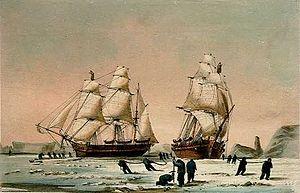
HMS Investigator was a merchant ship purchased in 1848 to search for Sir John Franklin’s lost expedition. She made two voyages to the Arctic and had to be abandoned in 1853 after becoming trapped in the ice. Her wreckage was found in July 2010 on Banks Island, in the Beaufort Sea. She was the fourth ship of the Royal Navy to bear the name.
Built at Scotts of Greenock and running 422 tonnes, Investigator was purchased by the Admiralty in February 1848 and was fitted for Arctic exploration by R. & H. Green at Blackwall Yard.
She was strengthened for Arctic service by William M. Rice, Master Shipwright of Woolwich Dockyard. She was extensively strengthened with timber (teak, English oak, Canadian elm) and 5⁄16 inch (8 mm) steel plating. Ten pairs of iron diagonal riders were set in the hold, with ten pairs of diagonal plates on the sides of the vessel between decks. To cope with snow and ice loads, the upper decks were doubled with 3-inch (76 mm) fir planking. Preston’s Patent Ventilating Illuminators were installed to improve light and ventilation. Sylvester’s Warming Apparatus, a modern stove system capable of warming the entire ship, was also employed with good results. The same or similar device had been used by William Edward Parry in 1821 to prevent condensation and aerate the lowest deck.
Later in 1848, she accompanied Enterprise on James Clark Ross’s expedition to find the missing Sir John Franklin. Also aboard Investigator on this expedition was the naturalist Edward Adams. She was commanded for the return voyage by Robert McClure, but became trapped in the ice, and was abandoned on 3 June 1853 in Mercy Bay, where she had been held for nearly three years. The following year, she was inspected by crews of the Resolute, still frozen in, and reported to be in fair condition despite having taken on some water during the summer thaw.
Unlike the loss of Erebus and Terror, the events surrounding Investigator’s abandonment are not a mystery. McClure provided an official account of the journey, and the ship’s surgeon Alexander Armstrong published an unofficial account in 1857. However, the location of the wreckage was not known for over 150 years because of difficulties reaching the area, which is inhospitable and often covered in ice.
Oral traditions of the Inuit tell stories of the ship. The abandoned ship was a source of copper and iron for the indigenous people in the area; metal nails were missing from smaller boats on the shore when they were discovered. One Inuit account from 1910 noted that "one year she had still been on the beach and the next year she was gone without a trace". When Canadian anthropologist Vilhjalmur Stefansson reached Mercy Bay in 1915 during his voyage to the Arctic, he failed to find her remains. After meeting the Inuit who made pilgrimages to the wreckage, he suggested a link between the Investigator’s stranding and the absence of muskoxen on Banks Island. He speculated that the Inuit had killed off the animals during their journeys to and from the wreckage over the 40 years since abandonment. The muskoxen have since repopulated the island and now number nearly 50,000.
In July 2010, a team of Parks Canada scientists, archaeologists, and surveyors began searching for the sunken Investigator in Mercy Bay at the northern tip of Aulavik National Park. It was the first expedition to search for the ship. The team arrived on Banks Island in the Beaufort Sea on 22 July and began a sonar scan of the area three days later. The ship was detected in the scan 15 minutes later. In order to confirm the discovery, the team made more than a dozen sweeps of the area over the next hour. Its remains were discovered on the shores of the island with the deck of the ship about eight metres below the surface. According to Ifan Thomas, a superintendent with Parks Canada, the ship was found "sitting upright in silt; the three masts have been removed, probably by ice". The cold arctic water prevented the outer deck from deteriorating quickly. There are no plans to raise the ship’s remains, although the team will send a remotely operated underwater vehicle to take photos of the underwater portion of the ship.
A team of six Parks Canada archaeologists, led by Marc-Andre Bernier, scheduled dives on the Investigator site for 15 days beginning on 10 July 2011 to gather detailed photographic documentation and mapping of the wreck. This will be the first human contact with the wreck, which lies partially buried in silt 150 meters off the north shore of Banks Island.
Thanks to Wikipedia
Kathy Dowsett
www.kirkscubagear.com